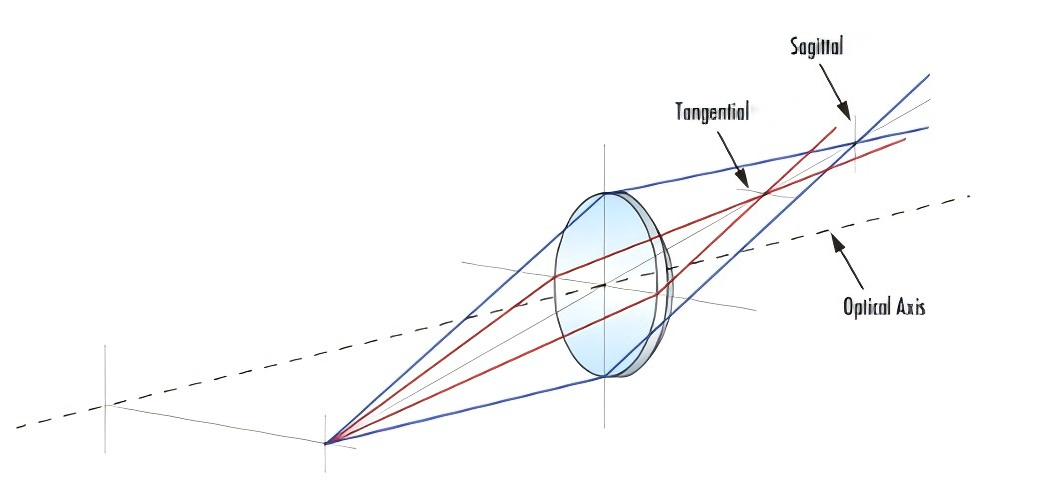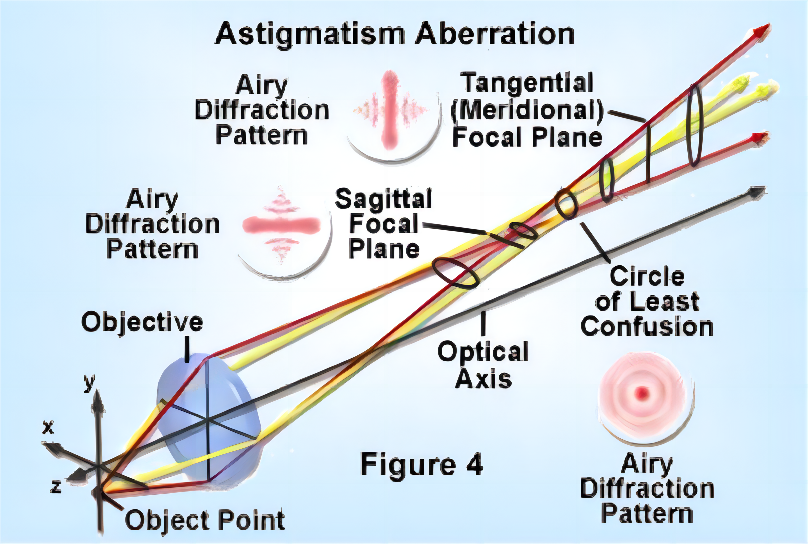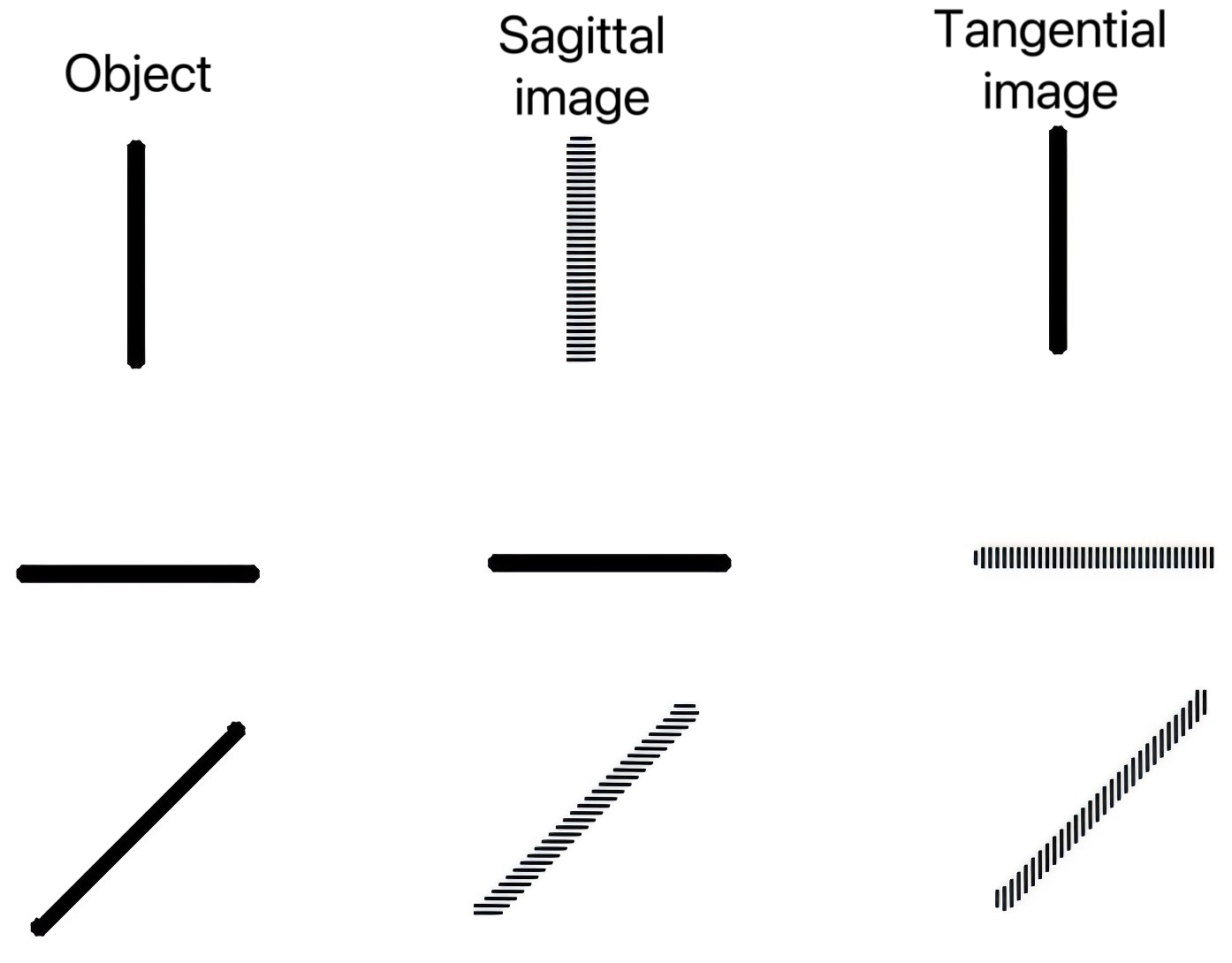1 Introduction
In the precise world of optical systems, astigmatism, a common type of aberration, has a profound impact on imaging quality. It not only affects image clarity but is also directly related to the overall performance and application scope of optical systems. This article delves into the definition and causes of astigmatism, explores its impact on various optical systems, and details how to effectively correct and optimize astigmatism in optical design.
2 In-depth Analysis of Astigmatism
Definition: Astigmatism refers to the phenomenon where the sagittal and tangential focal lines of a cone of light emitted from an off-axis point do not coincide on the image plane after passing through an optical system. This misalignment results in an elliptical light spot on the image plane instead of an ideal point source image.
Geometrical Explanation: From the perspective of geometrical optics, astigmatism arises due to the difference in the refractive or reflective abilities of the optical system in different directions. Specifically, when light enters the system off-axis, the difference in optical path lengths in the sagittal and tangential directions leads to the separation of the focal points.


Astigmatism: The sagittal and tangential rays from an off-axis point fail to converge at a single point.
3 Causes of Astigmatism
Lens Shape and Structure: Different lens shapes and curvatures have varying refractive effects on light, especially with aspherical lenses. Even slight design differences can significantly affect astigmatism.
Relative Position of Optical Components: The relative positions of the components in the optical system determine the light's path. Improper positioning can increase the optical path difference between the sagittal and tangential directions, exacerbating astigmatism.
Aperture Stop Impact: The position and size of the aperture stop directly determine the range of light entering the optical system. An improperly placed or oversized aperture can lead to greater astigmatism in off-axis light passing through the system.
4 Impact and Applications
Imaging Quality: Astigmatism is one of the main factors causing image blur and distortion. In precision optical instruments such as microscopes and telescopes, astigmatism can significantly reduce resolution and clarity.
Optical Design: In optical design, astigmatism is one of the key aberrations that need to be addressed. Designers must use precise calculations and simulations to optimize the structure and parameters of optical systems to minimize or eliminate the impact of astigmatism on image quality.

5 Challenges and Solutions in Optical Design
Challenges:
Complexity: The complexity of optical systems increases the difficulty of astigmatism correction. In systems with multiple lenses and light paths, the interaction between components makes astigmatism correction more complicated.
Precision Requirements: High-precision optical systems demand extremely high accuracy in astigmatism correction. Even small errors can lead to a significant decline in imaging quality.
Cost Considerations: High-quality corrective components and precise manufacturing techniques often come with high costs. Balancing image quality with cost control is a crucial issue in optical design.
Solutions:
Optimizing Lens Design: Advanced design techniques, such as aspherical and freeform lenses, can more accurately control light propagation and refraction, reducing astigmatism.
Precise Simulation and Testing: Optical design software can be used for accurate simulation and optimization. Adjusting the system's structure and parameters can minimize astigmatism, while actual testing ensures that image quality meets expectations.
Special Materials: Selecting special optical materials with low dispersion and astigmatism can improve image quality and reduce correction difficulties.
Comprehensive Correction Techniques: A combination of various correction techniques (e.g., lens combinations, aperture optimization, optical coatings) can achieve comprehensive astigmatism correction and optimization.
Astigmatism, as an important aberration in optical systems, significantly impacts imaging quality. By thoroughly analyzing its causes and effects, and exploring the challenges and solutions in optical design, we can better understand and master astigmatism correction and optimization methods. With continuous technological advancements, we will be better equipped to address astigmatism and other aberrations, driving further progress in optical technology.
Post time: Sep-13-2024

